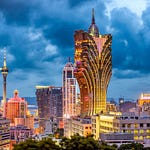Welcome to East West Hurricane! 🌪
We update you on the most essential news from Asia in tech, media, and business—the things you need to know that you probably haven’t heard in Western media.
Follow us on Twitter and Instagram! ⚡️
Trends in the Male Beauty Industry 💆♂️
The Male Beauty industry is getting more and more prominent every year, with some reporting that the men’s personal care market will reach $166 Billion globally by 2022. China is one of the world’s leaders in male beauty and actually is the biggest market in the world for men’s facial moisturiser use, with 65% of consumers using the product regularly. 96% of Chinese men have purchased cosmetics over the previous year and sales volume of men’s skincare products have doubled over the same time period.

Classic stereotypes around what beauty means for men and women is changing. Many Chinese brands have adjusted their marketing to break traditional cultural taboos about male personal care and several startup brands have carved out market share in the male beauty niche. On social media like Weibo, Douyin, and Kuaishou, male beauty tutorials and videos about skincare routines are becoming more popular. This growing consumer category in China is following other Asian countries like South Korea and Japan, where male beauty products are an even bigger part of society.
The Latest Developments from Huawei India 📱
Huawei is one of the many Chinese companies that will suffer from the recent tensions between China and India. This week, Huawei announced that they would be laying off 60-70% of their staff in India and cutting their 2020 revenue targets by 50%. Their revenue projection is going from $700-800 Million this year to $350-500 Million. Huawei’s peak revenue in India was $1.2 Billion in 2017.

This situation is relevant to the other Chinese smartphone makers who are also heavily invested in India such as Oppo, Vivo, and Xiaomi. They are also suffering from the China-India political tensions and this leaves room for other companies to capture market share, like Samsung or Ericsson. The Indian government has also banned both Huawei and ZTE from supplying telecoms infrastructure for the country. ZTE has also announced a series of recent layoffs. While this isn’t the first time Chinese companies have had to deal with political tension, it still might be the most dire situation for them if you include additional consequences from the coronavirus.
Amazon Showcases Contribution to Indian Exports 🇮🇳
Amazon India launched its export business in 2015 to allow SMEs to sell e-commerce exports, with the goal to reach $10 Billion in export revenue by 2025. A lot of these sales come from major sales holidays in the US like Black Friday or Cyber Monday. Given the current political climate, it’s in the best interests of any foreign company to emphasise all the contributions they are making to the Indian economy.

While India actually showed negative growth in exports in Q1 of this year, many government officials are describing e-commerce marketplaces as a way to boost India’s ability to export goods globally. The export business has also been a priority for Flipkart, Amazon’s primary rival in India. Last week, Amazon said that their export program has allowed 60,000 Indian exporters to sell $2 Billion worth of Indian products to international customers over the previous two years. And I’m sure they will be highlighting even more progress as time goes on.















Share this post